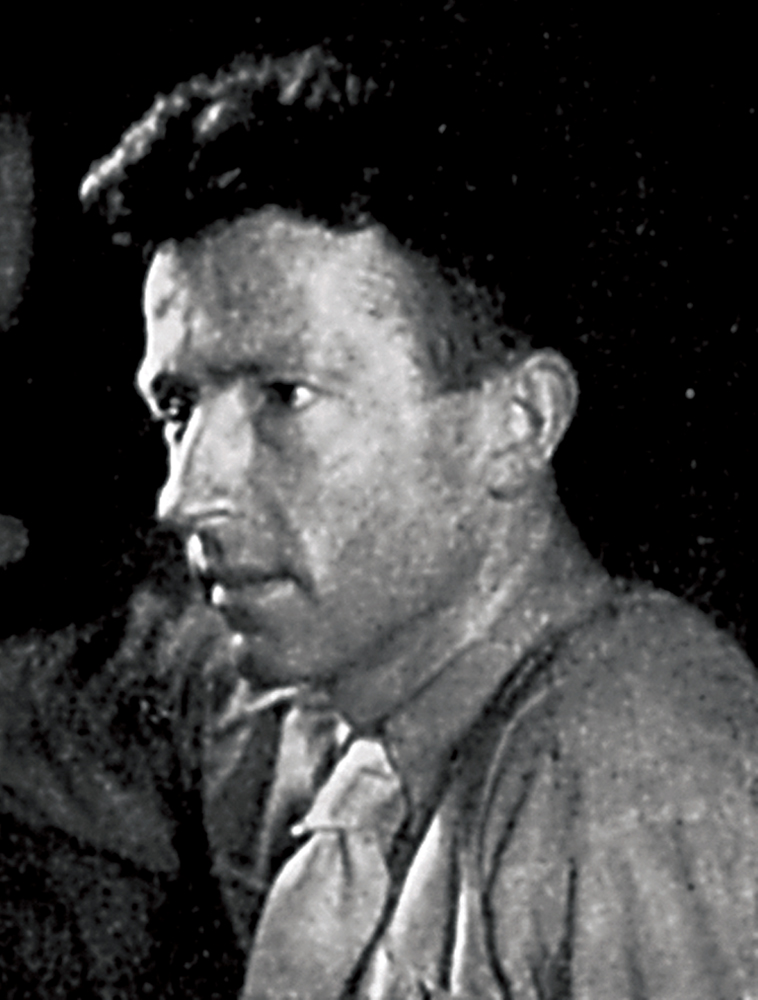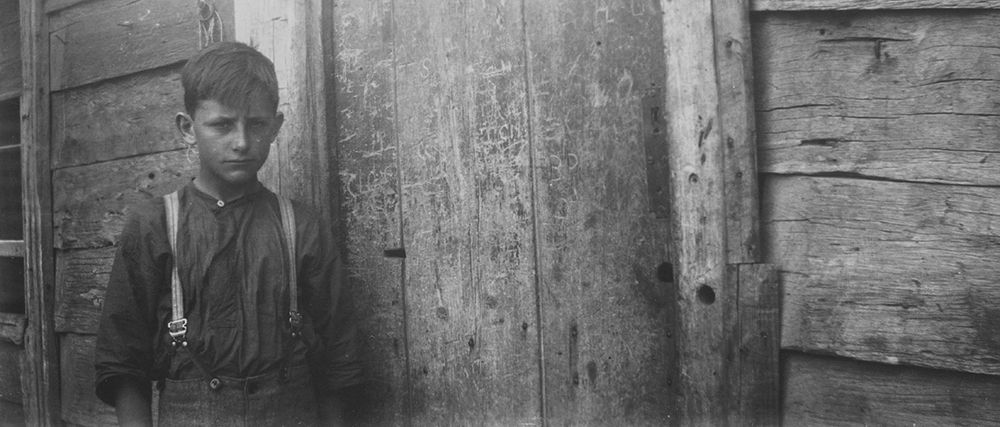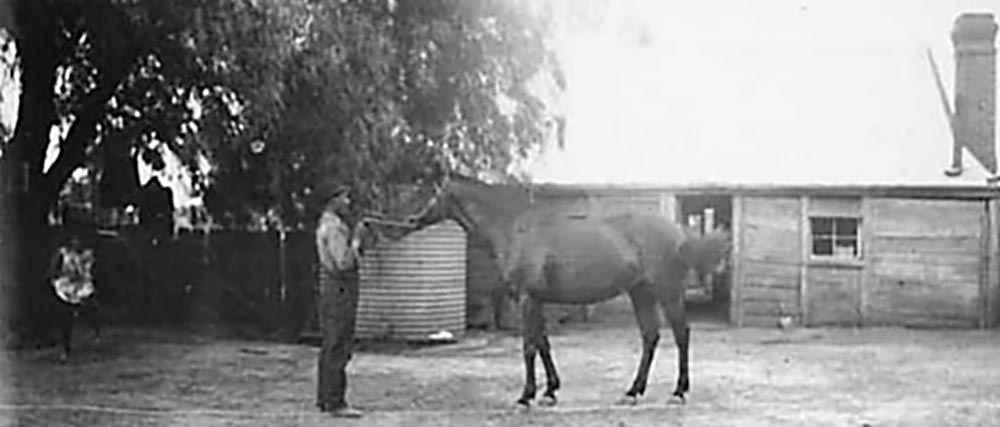Australian Son
The description below appeared on the dust jacket of the 1956 Georgian House edition of Australian Son: A Life of Ned Kelly.
Australian Son was written in a loft over an old coach-house in East Melbourne, not far from where famous Australian novelist Henry Handel Richardson lived, between January, 1946 (when the author was discharged from the R.A.A.F.), and May, 1947. Besides time and effort, it cost the author his deferred service pay and all he had saved in New Guinea.
Max Brown was born in Invercargill, N.Z., but came to live in Melbourne, Australia, at the age of eleven. He has been clerk, salesman, student teacher, fitter and turner, journalist. He is handy with tools, criticises the literary and other efforts of his friends, has a passion for Gauguin, Bach, Fats Waller, the aesthetics of Christopher Caudwell and the plays of Sophocles, is keen on sport and claims, with a note of optimism, that there are not 1,000 Australians who have swum further than he in the past twenty years.
“I will try anything once”, he says. “But I will not back horses, tread on my fellow man, or close my eyes to the dilemma of the modern world.”
He declares: “It was not until I left my country during the war and met men of other races that I developed a pride in my own mates and in certain unique traditions of the Australia which sweats in the sun and whose words as yet are few and laconic.”
Max Brown on Ned Kelly
 I cannot remember when I first heard of Ned Kelly and the youths who were his comrades, who flamed among these sombre hills towards the south-east corner of my Australian continent in the days of the lion rampant. I can imagine good Queen Victoria – assured, satisfied, and with a tendency towards obesity – yet at the summit of her age – was the perfect emblem of the dominant, middle-aged, middle-class, righteous British Empire of the loud steam age in which they lived. Amid huzzahs of petty wars for the enlargement of Empire, fought to the accompaniment of music-hall ditties, her plump hand never trembled, her name remained virtue.
I cannot remember when I first heard of Ned Kelly and the youths who were his comrades, who flamed among these sombre hills towards the south-east corner of my Australian continent in the days of the lion rampant. I can imagine good Queen Victoria – assured, satisfied, and with a tendency towards obesity – yet at the summit of her age – was the perfect emblem of the dominant, middle-aged, middle-class, righteous British Empire of the loud steam age in which they lived. Amid huzzahs of petty wars for the enlargement of Empire, fought to the accompaniment of music-hall ditties, her plump hand never trembled, her name remained virtue.
Yet, I suspect, that behind the name of evil given these young men was a certain worth little understood then or now, which, in a perverse way, put the seal of manhood on our young Australian nation; and that their fame, which made the bushland ring, will therefore never cease to ring in Australian hearts.
For what is virtue as conceived by the lions of the earth but the image of their own fast bodies and terrible jaws? What is contempt, but their attitude to the horse or the antelope? And what is evil so much as opposition – in particular, the defiance of those they have evoked gods and strange devils to terrorise, but who, because of the quality of forged power within them, turn and advance without dismay to give battle?
Strange that four such young men, born of the soil, educated by few books, but by the deeds of men and the signs of earth, should live so briefly and be remembered so long in spite of the fiercest campaign of calumny the young colony had witnessed.
People are not remembered for nothing; and Kelly, over seventy years dead, his own defence till now denied a hearing, will not lie down. Why, otherwise, should I add to the packed shelf of Kellyana?
Was it the war which gave me a greater sense of the validity of my own country? Was it that in myself and in the men with whom I lived I found a certain unique Australian character – a promise and a threat, which had found expression in the life of Kelly many years before?
On my way north in ’45, in sound of Sydney surf, I idly bought a cheap, brightly-coloured booklet which I read in shadow of the Black Stump. Not knowing and scarcely caring what else had been written, I decided, when I returned to Melbourne in peace, to take a year off and write a book on the Kelly gang.
In a year I have been to many strange places following chance or deliberate word.
In the Melbourne Public Library and the Mitchell Collection, I have read every line I could find which dealt with the gang, and much about the life of their time. I have visited many of the old haunts, travelled across their country, spoken with old people who remember them. I have seen evidence of the time in the opulent cornices and enduring workmanship of private mansions and public buildings, and in the squat homes of the common people. I have narrowed my eyes in the twilight of scarred clearings and imagined the roaring days of the golden plague. On some farm I have come across an old toolshed built of slabs – once the home of a settler in the days of the pit saw. I have pulled the bootlace latch as so many men before, end entering the gloom, have noted the broad hearth and the rusted camp oven, and up against the wall a rough-hewn stool; and it has not then been so difficult to hear again the voices of the selector and his wife, and the chatter of the barefoot children. I have asked the old man who showed me around: ‘Did you work hard in the old days?’ And with the ghost of a hearty laugh he has replied: ‘Work hard? Why, they used to put a bag over the sun so we wouldn’t see it go down.’

Out of rain or sun in spacious stables dead with the smell of dust and benzine and incongruous with sleek, beetle-shaped automobiles, I have seen the wooden stalls as they were, each with its mount. I have heard them whinny and champ in the night. I have smelt whiffs of hay and horses and the ripe tang of manure. I have seen again the days when the iron horse was advancing, but still the horse was king, when benzine was hay, the service station the farrier’s forge, the days when the flasher your horse and the flasher your gear, the damn sight flasher you were.
But dream as I can in the shadow of the Alps where these four young bushmen rode, I shall never savour the tang of their voices, hear them laugh or curse, feel with my hand against their hearts, the impact of the first great disaster, of their summer triumphs when the electric telegraph flung their deeds across the world, of the days of waiting, of boredom – the black days of decay and futility towards the end – and of the final, desperate lunge to revenge themselves on the police claw of officialdom which they never ceased to contend had harried them without just cause.
In books new and old, in old documents and official reports, in the stained files of newspapers, in the dumb evidence of trees and rocks and tracks and old buildings, in the quavering voices and still bright eyes of old folk who knew them, but are soon to die, I have read something. Sometimes I felt I had moments of insight into the enigma of their leader who has been described as low thief and murderer, and again as the father of our national courage – our General – our King – whose mystical presence is still growing about us, never to die. Other times I have felt it futile that I – insecure and living in these days of judgement – should ever try to concentrate my gaze to see behind these words and stones; and I have hoped for the day when a bolder and freer wit would write down that which I could not.
We have never known or have forgotten already. Hunted, tracked and spied on, and with a price on their heads, they themselves in statements which they tried to bring to the attention of people and government of the time, likely enough distorted the truth to justify themselves or put the police off the scent. How could they be expected to tell even close friends what they were up to when each had two thousand pounds on his head? What little the gang told was to an inner circle of relatives who stood by them till the end. These are dead; but even while they lived they said nothing, and had nothing but contempt for the tribes of hacks who, they said, were out to make blood-money from heroes.
Many writers have recorded many views and are praised or scorned according to prejudice, class-interest or their ability to write conventional English. As Kelly himself said, we must all be judged one day according to our mercy and our deeds; and anyone wishing to find how poorly most have done the job need refer little further than Kelly’s own statements and the seven hundred page Police Commission Report of 1881.
As for this work, suffice that I, setting out in January, 1946, with the tattered remnants of my youthful enthusiasm, declared to myself that I would leave no stone unturned, and that three months later I tramped along a country track bitterly disappointed, aware already of one great limitation placed on my aim, muttering to myself the first lines of a preface I would one day write: This is the story of failure; but from the ashes rises some achievement!
Already hands of the living and the dead had stretched out to seal my mouth. Already I knew there were great gaps in the Kelly history which I could not mend. Moreover, there were major issues concerning which were opposed accounts. Time, class-interest and perversity had done their job so that no effort of mine and the readily extended assistance of almost everyone to whom I went could solve these contradictions. I found each new avenue of research opened into a dozen pothers. I realised, finally, the truth I once regarded absolute was largely relative – in the eye of many beholders, as well as running its course in an earlier age; and that I was indebted to erring men for every record of Kelly and his times. It was merely that certain of the countless myths and records appeared to make a more credible pattern than others.

These, then, were points to be considered when I came to write. It may have been better to have written a novel in which I could have camped with Kelly, entered the conversation, gone from point to point imaginatively depicting the significance these men to their time and ours. But I would have had to invent situations and write whole chapters on the slenderest material.
What I finally decided to do was to select, as I believed, the most valid aspects of the myth – to let Kelly speak more freely than to date; and, without making new bricks, to re-create from the buried rubble some sort of ruin which might stand for a time.
Yet, incomplete, erroneous in some details, and ill-conceived as this account may be, it will, nevertheless, do some justice to a man who, in his day, appeared to many not as a black-hearted murderer, but as a new Messiah of Australian democracy.
A legend says when the die was cast and Kelly was fated to follow the course to inevitable eclipse, he approached his mate, Joe Byrne, like Christ summoning His disciples, and said: ‘What about it Joe?’ – to which the latter replied: ‘I’ll tell you what I’ll do. I’ll hit the earth with this stick and if it breaks I’m with you.’ Whereupon, he lifted a dead stick from the ground and smashed it on the granite outcrop at his feet, laughed, flung the stump away, jumped on his horse, and rode off with his mate up the bridle track over the ranges.
It says, also, that when Ned approached Steve Hart as he chopped wood on his father’s land, Steve laughed also, tossed his axe on to the heap, said: ‘Here’s to a short life and a merry one!’ and went off to saddle his nag and join his leader.
It declares that in the hour of his capture, the police took from Kelly’s pocket a declaration for a Republic of North-Eastern Victoria!
It is not legend – it is truth – that, in this hour, bleeding from his many wounds and staggering under his hundred pounds of ploughshares through the mist and half-light of the morning to join his mates, Kelly actually did assume supernatural proportions in the eyes of the troopers, who cried out to each other: ‘It’s the bunyip! It is the devil himself!’
Likewise, it was sober fact when Judge Sir Redmond Barry passed sentence and concluded with the words, ‘May the Lord have mercy on your soul!’ Kelly replied, ‘Yes, I will meet you there!’ – and that twelve days after Kelly was hanged, the honourable judge was killed no less effectively by a common ailment of the flesh.
Flowers open to the sun and close to the night. In the shadow of death through which he stalked for twenty months, Ned Kelly summoned up such aspects of heroism, dormant in all but a few of us, that some who have known the commoner rut say this man was approaching the stature of god or devil. So does the myth become greater than the reality to react upon reality!
Excerpt from 75th anniversary of 'Australian Son'
The following excerpt was taken from a speech made by Brad Webb at Greta on Saturday, 24 February 2018 to celebrate the 75th anniversary of the release of Max Brown’s book Australian Son.
Maxwell MacAlister Brown was born on 21 March 1916 in Invercargill, New Zealand and came to live in Melbourne at the age of eleven. After completing his education, Max worked as a journalist in Melbourne, Sydney and Perth, as well as in country towns in New South Wales and Western Australia. At one stage, he worked in Melbourne on The Argus with fellow journalist and soon-to-be famous Australian novelist George Johnston, author of My Brother Jack, whose volatile marriage with writer Charmian Clift would be the subject of Brown’s final book, Charmian and George, which was published in 2004 by Rosenberg Publishing in Sydney.
Max also worked as a clerk, teacher, salesman, fitter and turner, wharf labourer, and film publicist. During the Second World War Max Brown served in the Royal Australian Air Force. Max, like many who emerged from the chaos and destruction of the Second World War, entered the postwar world in an immensely positive frame of mind. A new world had to be created which would be better, and wiser, having learned from the mistakes of the past. Before long this positive view of the future had been overwhelmed by the Cold War, but not before certain creative achievements had taken place.
The late 1940s would be a watershed moment for the legend of Ned Kelly. Two significant events would propel Ned back into the spotlight. The first was Sidney Nolan’s 1946 to 1947 Ned Kelly series of paintings and the other was Max Brown’s 1948 release of Australian Son which was described by The Times in London as “…Mr Brown has the stuff of a writer in him and tells the story of the Ned Kelly episode with gusto and enthusiasm.”
Australian Son was written in a loft over an old coach-house in East Melbourne, not far from where famous Australian novelist Henry Handel Richardson, author of The Getting of Wisdom, lived. Between January 1946, when Max was discharged from the R.A.A.F., and May 1947, Max devoted his time, and most of his deferred service pay and all he had saved in New Guinea, to a period of research into the life and times of the Kelly Gang.
The book has long been recognised as the classic account of a turbulent, formative period in the history of Australia. Since then, a number of other writers have produced books on the Kelly outbreak, adding to the available knowledge and the variety of possible viewpoints on the celebrated events. Australian Son, was the first modern account of the Kelly outbreak. Works prior to this tended to fall into bias categories either for or against. Max Brown’s book was the work of an open-minded outsider who had put time and effort into studying the events of the Gang’s lives on the ground, in the caves, the ranges, and the rough dwellings – wherever the incidents occurred.
After publishing Australian Son in 1948, Max went on to write a number of other books which primarily centred around indigenous themes. His 1966 novel, The Jimberi Track, tells a story of harassment by white settlers and miners directed towards the indigenous population which included the Wongais in South Australia and Western Australia after the Second World War. Max also published The Black Eureka, an account of the 1946 Pilbara strike by Aboriginal and part-Aboriginal stockmen in the north of Western Australia.
However, Australian Son remained Max Brown’s most significant contribution to Australian literature. Max’s book has featured prominently in later historical examinations of the story by authors and historians such as Ian Jones, John Molony, Frank Clune, Keith McMenomy, John McQuilton, and Graham Seal among others. Max Brown, having influenced numerous writers, had read their work and felt that he needed to incorporate later discoveries (some his own, some by associated researchers) and later viewpoints on the events in his own revised account.
Max decided to bring his early classic up to date; those who know his first account, or its 1956 revision, will find much that is familiar in this final version of the story, and quite a lot that is new. Prior to his passing, Max had spent the good part of the previous ten years rewriting Australian Son. Eager to reintroduce his book to the twenty first century, Max had sourced new material and updated many of this fine theory’s and findings. His manuscript, however, was still in multiple re-writes when he suffered a debilitating stroke. Upon his death, Max’s close friend Chester Eagle took it upon himself to undertake the mammoth task of comparing Max’s papers, notes, and the five surviving manuscripts (including the one’s Max had given Brad Webb, Chester Eagle, and Ian Jones) page by page to determine which sections were the most recent.
After months of work the end result was then scanned using optical recognition software, as Max had originally used an ancient word processor whose disks had gone missing during the removal of his belongings from Stockton in New South Wales to Sebastopol near Ballarat. These scanned pages were then converted into a Microsoft Word document which was carefully re-read by Chester – who compared each scanned page to its original, ensuring a perfect transfer.
Over the course of seventy-years Australian Son has been published by Georgian House of Melbourne in 1948; a revised edition by Georgian House in 1956; by Angus and Robertson in their 1981 Australian Classics series; and Max’s final revision published by Network Creative Services in 2005 to commemorate 125th year anniversary since the death of Ned Kelly. In 2013, Max’s masterpiece was re-released in both hardback and digital editions and the subsequent reprints will ensure his legacy is never out-of-stock.
Bibliography
Australian Son: the story of Ned Kelly (1948)
Wild Turkey (1958)
The Jimberi Track (1966)
The Black Eureka (1976)
Buttered Toast: Stories and Sketches > Quinn Tea (1999)
Charmian and George (2004)
Link
The Wars Were Over by Chester Eagle
(a Max Brown biography)
